
Fiber Splicing Machines: A Backbone of Modern Connectivity
In today’s era of digital transformation, fiber optic cables form the backbone of high-speed internet and telecommunications. A critical aspect of maintaining and extending these networks is fiber splicing, the process of joining two optical fibers. At the center of this process is the fiber splicing machine, a precision tool that ensures seamless communication across networks.
What is a Fiber Splicing Machine?
A fiber splicing machine is a device used to fuse two optical fibers, ensuring minimal signal loss and reflection. It plays a pivotal role in installing, maintaining, and repairing fiber optic networks.
Types of Fiber Splicing
1. Fusion Splicing:
Uses heat (electric arc or laser) to weld fibers together.
Produces a low-loss, high-strength splice.
2. Mechanical Splicing:
Aligns fibers using a mechanical fixture and index-matching gel.
Faster but less durable compared to fusion splicing.
Features of a Modern Fiber Splicing Machine
Precision Alignment: Ensures minimal splice loss using core-to-core alignment technology.
Compact Design: Lightweight and portable for field operations.
User-Friendly Interface: Touchscreens and automated processes simplify operations.
Built-in Testing Tools: Measures splice quality and strength.
Applications of Fiber Splicing Machines
Telecommunications: Extending and repairing fiber optic networks.
Data Centers: Managing high-speed data transmission.
Medical and Military Equipment: Splicing specialty fibers for precision applications.
Submarine Cables: Ensuring robust connectivity across continents.
Advantages of Fiber Splicing Machines
Low Signal Loss: Ensures efficient data transmission.
Durability: Creates long-lasting fiber connections.
Cost-Effective: Reduces network maintenance costs over time.
Conclusion
The fiber splicing machine is a cornerstone of modern connectivity, ensuring the seamless transfer of data across vast distances. Its role in maintaining and advancing fiber optic networks makes it indispensable in our increasingly connected world.
Here’s an illustration of a modern fiber splicing machine:
